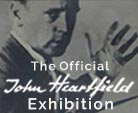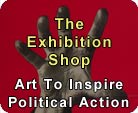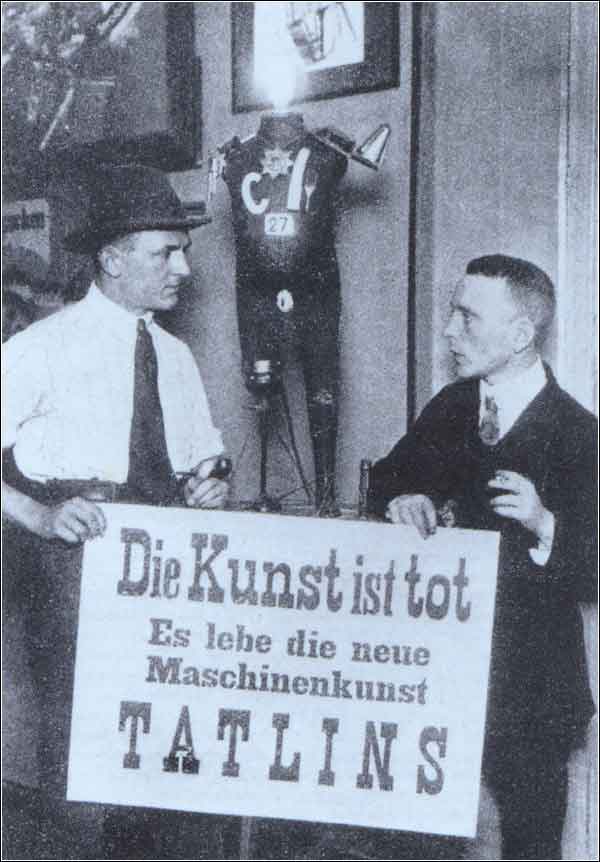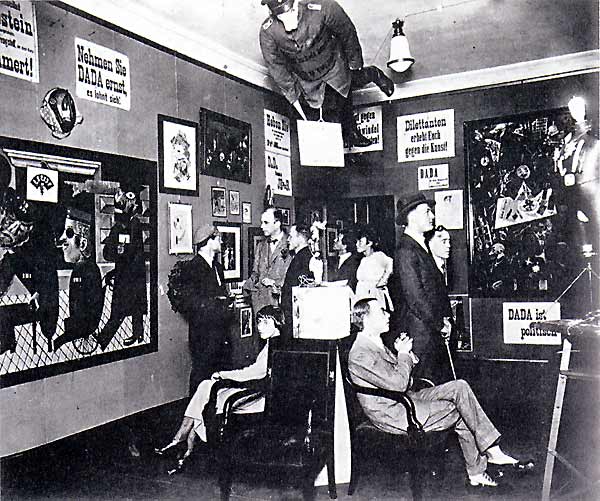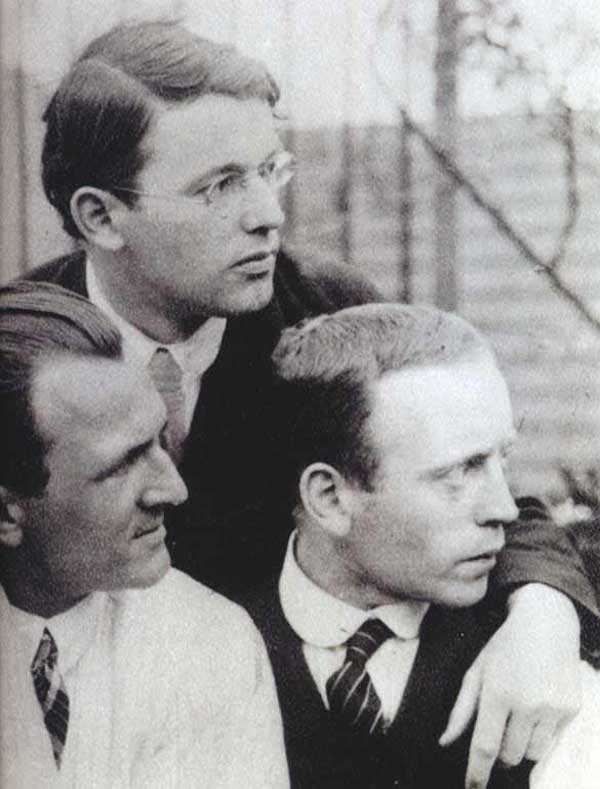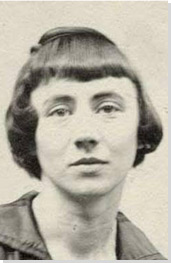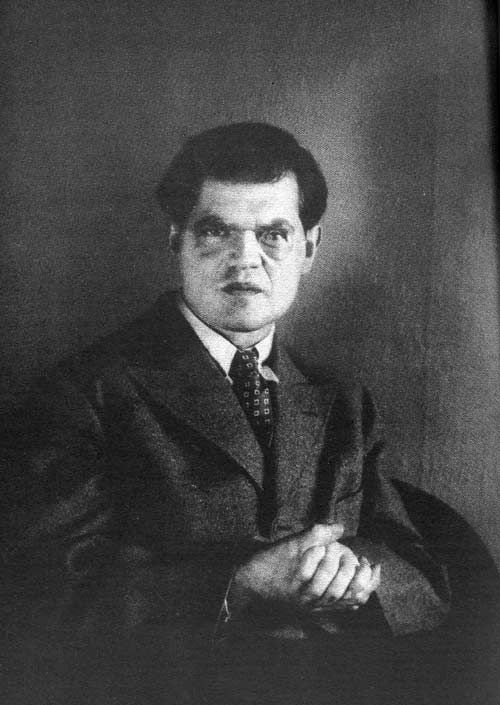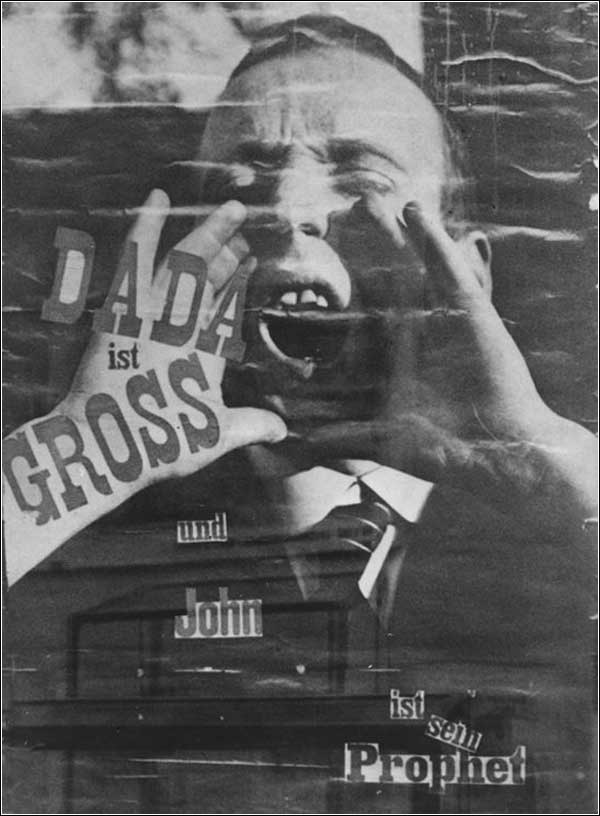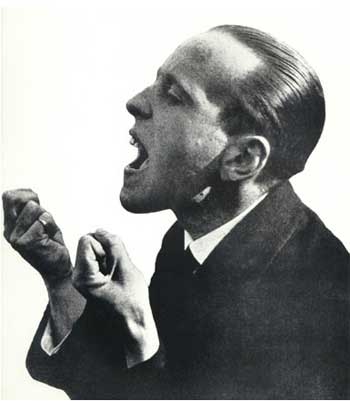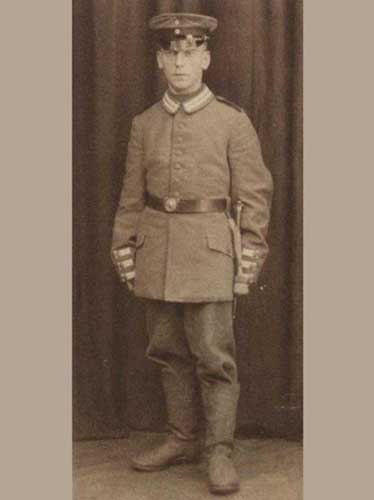
Berlin Dada Artists. Art Rebels Grosz Heartfield Höch Hausmann Schlichter – Members Of Berlin Club Dada
DADA DADA ARTISTS DADA ART DADA IN PRINT
Berlin Dada Artists. The Berlin Club Dada Art Rebels.
CLICK IMAGES TO ENLARGE
The young John Heartfield was conscripted into the Kaiser Wilhelm regiment. Grosz and Heartfield holding up a sign proclaiming that, "Art is Dada. Long live the new machine art." Shown are participants in the opening of the First International Dada Fair at the Otto Burchard Gallery in Berlin, June, 1920. Wieland Herzfelde made it possible for his brother, John Heartfield, to join the astonishingly vibrant Berlin art scene of the early twentieth century. That, in turn, made it inevitable that John would meet the man who changed his life, the genius George Grosz. The following is a quote from The Art Story, Modern Art Insight webpage: Before he encountered the members of Berlin Dada in 1917, Raoul Hausmann was a follower of Expressionism. The typically groundbreaking typography reading "DADA ist GROSS und John ist sein Prophet" on this self-portrait of a shouting John Heartfield could easily read, "Dada is BIG (a not-so-veiled reference to German Dada giant George Grosz) and John is (his or its) prophet." This portrait of Berlin Dada artist John Heartfield could encapsulate the energy, anger, passion, and spirit of German Dada and the artists of Berlin, 1916-1920.John Heartfield, Eyes Opened By WWI
He witnessed the horrors of the WWI front that the world was led to believe were noble and heroic.
This experience deeply instilled in Heartfield a lifelong hatred of war, ignorance, and hypocrisy.
His rebellious nature was formed early. It was a perfect match for the artistic rebellion of Dada.
"We were supposed to play letter carriers and deliver the [Berliner] Lokal-Anzeiger, that despised war-mongering paper, to the philistines of the Grunewald district, along with their letters. I went to the nearest storm drain and threw the letters and everything into the culvert." John HeartfieldDadaists George Grosz and John Heartfield
First International Dada Fair, Berlin, June 1920
Standing (left to right): Raoul Hausmann (artist), Otto Burchard, Johannes Baader (writer and artist), John Heartfield’s brother, Wieland Herzfelde, born Wieland Herzfeld, and his wife, Margerete Herzfelde, George Grosz (artist), and John Heartfield, born Helmut Herzfeld, (artist). Seated (left to right): Hannah Höch, born Anna Therese Johanne Höch, (artist) and Otto Schmalhausen (artist).
Although it was billed as the "first" Dada fair, it was actually Dada's last hurrah.
The Dada art movement, one of the few art movements named by the artists rather than the critics, burn brightly and quickly.
Berlin Dada began circa 1916 and was over by 1920. However, its influence in art and culture remains strong to this day.Grosz, Schlichter, Heartfield in 1922
Grosz's view of what was art and what was pretty pictures for the bourgeoisie stunned Heartfield right out of his early formal art training
Grosz and Heartfield soon became close friends and collaborating artistic rebels.The Brilliant Dada Artist Hannah Höch
"Höch was not only a rare female practicing prominently in the arts in the early part of the twentieth century - near unique as a female active in the Dada movement that coalesced in her time - she also consciously promoted the idea of women working creatively more generally in society.
She explicitly addressed in her pioneering artwork in the form of photomontage the issue of gender and the figure of woman in modern society.
Her transformation of the visual elements of others by integrating them into her own larger creative projects evidenced a well-developed early example of "appropriation" as an artistic technique."
Clicking VIEW PAGE will take you from the Exhibition to the web page where more information is available on Hannah Höch.A Portrait Of Dada Artist Raoul Hausmann
The contemporary literature of magazine such as Cabaret Voltaire, as well as the influence of writer Richard Huelsenbeck, had a profound influence on Hausmann's view of art.
By 1918, Hausmann was an active participant in Berlin Dada along with Huelsenbeck, Heartfield, and Grosz. In 1918, Club Dada was founded and the first “Dadaist Manifesto" was published.
Raoul Hausmann printed his first "poster poems" and phonetic poems.
In 1919, Hausmann became the editor of the Berlin Dada journal Der Dada.The Prophet Of Berlin Dada
Click "VIEW PAGE" to view samples of the Dada art creating by the team of George Grosz and John Heartfield.The Spirit Of Berlin Dada
If artists such as Grosz, Höch, and Hausmann were the mind of Dada, Heartfield represented its fervent emotions.
During their cocaine and alcohol feuled get togethers, the Dadaists tied Heartfield to chair and then taunted him. They wanted to see just how angry a human could be made. By all accounts, Heartfield did not disappoint.

Berlin Dada Artists. The Berlin Club Dada Art Rebels.
A list of German Dadaists must at least include George Grosz, John Heartfield, Hannah Höch, Raoul Hausmann, Hugo Ball, Emmy Hennings, Hans Arp, Johannes Baader, Richard Huelsenbeck, Kurt Schwitters, Hans Richter, and Max Ernst.
Currently, this page only features a selection of those brilliant artists who made up the Berlin Dada Movement. More German Dadaists will be added in coming weeks.
Club Dada Members, such as George Grosz and John Heartfield, weren’t simply a collection of dazzling genius. They were rebels. Their parties were complete with cocaine, alcohol, and intense political arguments. Grosz was a dandy who was fond of flamboyant outfits and makeup. Heartfield was a one-man political force.
John Heartfield Describes A Dada Event
John Heartfield gave this account of German Dada art rebels in an interview with Roland Märx in 1967.
“And it even went so far that we disrupted our friend Theodor Däuber, when he was giving readings, a great poet with his Nordlichtgedichte (Northern Lights Poems) , yes, a very pleasant, likeable person, a great man whom we loved very much. […] He would give reading, we would disrupt them, and he would always say, ‘Oh, tonight. The Dadaists are coming.’ That became our cue […] we would put on our performance. […]
An old codger with a goatee would come along […] so inhibited and decrepit. Then we would say, ‘you’re the very one; didn’t Chaplin send you? Did Chaplin send you? We’ll have to telegraph our thanks right away.’ […] And so we engaged him on the spot. Then we had a cardboard box. We had a big wreath of violets and those dear Dadaists of yours. Those dear Dadaists friend of your put it in the cardboard box with silk and ribbons. We then ordered the man to carry it up front. And that was an order, when we gave him the signal, when we stood up and sang. We drummed that into him. Then he had to go in, go through the doors, carry the box up front to the rostrum when Däuber was reading the wonderful Nordlichtgedichte (Northern Lights Poems). And, would you believe it, it happened. The door opened and he came in, old and frail ~ wonderful ~ went forward with the thing, and we stood up and sang, “We’ll make you a bridal wreath of azure silk.”
Everyone froze. He too, the messenger-boy. He stumbled. The box fell open, the wreath fell out. Our friend Däuber fled to the rear. The reading broke up.”
